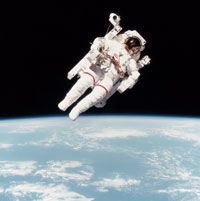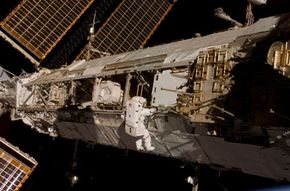Types of Spacewalks and Necessary Equipment
Once the hatch to the exterior airlock is open and the astronaut pokes his or her head out into the void, several tools give a variety of support to a spacewalker. One of the most important pieces of equipment makes sure astronauts don't fly away from the spacecraft and either burn up in the Earth's atmosphere or venture off into the deep nothing of space. A crewmember safety tether, the equivalent of a simple rope, keeps an astronaut on a spacewalk completely attached to the shuttle or station.
Safety tethers are 55 feet (16.8 meters) long, ensuring the necessary mobility, and they're attached at all times to a waist tether by a large hook. Extra tethers on the wrists keep hand tools from flying away. Slidewires, handrails and footholds are also added to spacecraft to make it easier for spacewalkers to move around and perform simple jobs like turning a nut with a wrench.
Advertisement

Spacewalkers can also use manned maneuvering units (MMUs), larger propulsive vehicles attached to space suits, for extra mobility and more complicated tasks. Astronauts always bring along simplified aid for EVA rescue (SAFER), which are smaller, emergency MMU systems that are attached to the space suit's backpack.
If an astronaut gets thirsty during a spacewalk, suits are equipped with an in-suit drink bag (ISD), which is just a plastic water-filled bag with a drinking tube that's attached by Velcro to the front interior of the suit. Astronauts just turn their head toward the tube and take a sip. Although suits used to attach fruit bars near astronauts' necks, most spacewalkers today prefer to eat before they exit spacecraft.
There are three basic types of spacewalks:
- A scheduled spacewalk is any EVA that's part of the plan. Many space shuttles will fly up to space stations with several goals in mind, and one of those goals may be to replace some faulty wires or tighten up any loose screws on a spacecraft. A spacewalk will, of course, be necessary to complete this goal, so it will be an important part of a mission's schedule.
- An unscheduled spacewalk is one that wasn't part of the mission's flight plan but is necessary for its completion.
- A contingency spacewalk is the same as an unscheduled one, but it must be done to ensure the safe return of the crew and spacecraft.
Extravehicular activities are also divided up by level of complexity. A simple EVA uses few tools or mobility techniques, and astronauts don't need a lot of training or briefing before these types of spacewalks. An intermediate EVA might need special tools and equipment, and more in-depth training beforehand is probably necessary. A complex EVA requires more complicated technology and will most likely be difficult and dangerous to complete, and astronauts will need to have had a great deal of training. The type of training an astronaut usually receives, believe it or not, takes place in pools. Spacewalking is often compared to scuba diving -- the material used for space suits like neoprene and nylon, for example, is also used for scuba suits. After as many as 25 to 30 hours of practice in pools, astronauts have in fact compared the sensation of floating underwater to floating in space [source: NASA].
To learn more about interstellar travel and space exploration, see the articles below.
Related Articles
More Great Links
Sources
- NASA. Shuttle Space Kit: STS-93. http://www.shuttlepresskit.com/STS-93/scom.htm
- Oberg, James. "Astronaut." World Book Online Reference Center. 2005. World Book, Inc. http://www.nasa.gov/worldbook/astronaut_worldbook.html
- Petty, John. "Spacewalking." National Aeronautics and Space Administration. April 7, 2002. http://spaceflight.nasa.gov/shuttle/reference/faq/eva.html
- Schmitt, Tony. "Index of spacewalks by manned space program." Feb. 1, 2007. http://pages.prodigy.net/pxkb94ars/Spacewalks/index.html
- Vogt, Gregory. "Suited for spacewalking: a teacher's guide with activities for technology education, mathematics, and science." National Aeronautics and Space Administration. Washington, D.C.: Office of Human Resources and Education, 1998. http://www.nasa.gov/audience/foreducators/topnav/materials/listbytype/Suited_for_Spacewalking_Educator_Guide.html
